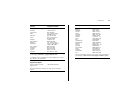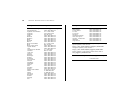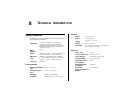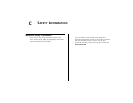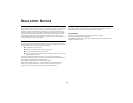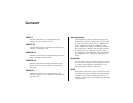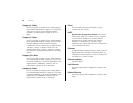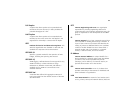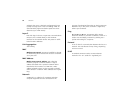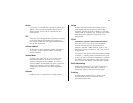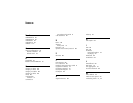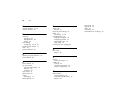
88 GLOSSARY
Category 3 Cables
One of five grades of Twisted Pair (TP) cabling defined
by the EIA/TIA-568 standard. Category 3 is voice grade
cable and can only be used in Ethernet networks
(10BASE-T) to transmit data at speeds of up to 10
Mbps.
Category 5 Cables
One of five grades of Twisted Pair (TP) cabling defined
by the EIA/TIA-568 standard. Category 5 can be used in
Ethernet (10BASE-T) and Fast Ethernet networks
(100BASE-TX) and can transmit data at speeds of up to
100 Mbps. Category 5 cabling is better to use for
network cabling than Category 3, because it supports
both Ethernet (10 Mbps) and Fast Ethernet (100 Mbps)
speeds.
Category 5e Cables
One of five grades of Twisted Pair (TP) cabling defined
by the EIA/TIA-568 standard. Category 5e can be used
in Ethernet (10BASE-T), Fast Ethernet (100BASE-TX) and
Gigabit Ethernet (1000BASE-T) networks, and can
transmit data at speeds of up to 1000 Mbps.
Category 6 Cables
One of five grades of Twisted Pair (TP) cabling defined
by the EIA/TIA-568-B standard. Category 6 can be used
in Ethernet (10BASE-T), Fast Ethernet (100BASE-TX) and
Gigabit Ethernet (1000BASE-T) networks, and can
transmit data at speeds of up to 1000 Mbps.
Client
The term used to describe the desktop PC that is
connected to your network.
DHCP
Dynamic Host Configuration Protocol. This protocol
automatically assigns an IP address for every computer
on your network. Windows 95, Windows 98 and
Windows NT 4.0 contain software that assigns IP
addresses to workstations on a network. These
assignments are made by the DHCP server software that
runs on Windows NT Server.
Ethernet
A LAN specification developed jointly by Xerox, Intel and
Digital Equipment Corporation. Ethernet networks use
CSMA/CD to transmit packets at a rate of 10 Mbps and
100 Mbps over a variety of cables.
Ethernet Address
See MAC address.
Fast Ethernet
An Ethernet system that is designed to operate at 100
Mbps.
Gigabit Ethernet
An Ethernet system that is designed to operate at 1000
Mbps.



